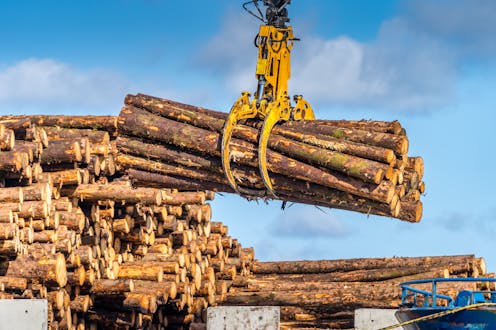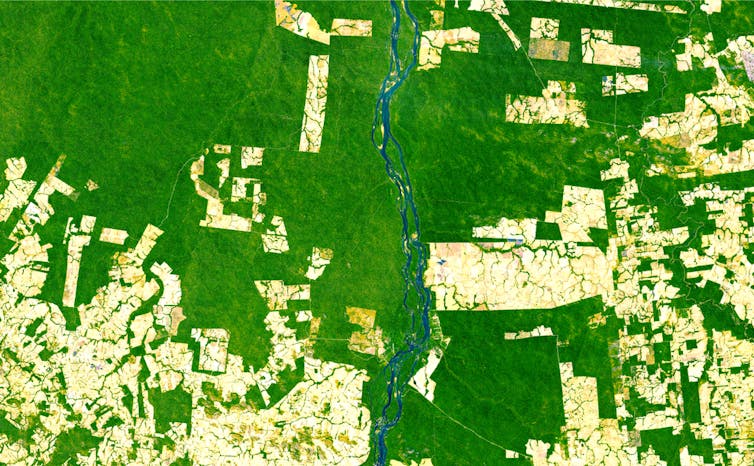
While farming continues to drive deforestation around the world, 60% of the destruction of Earth’s large, intact forests is caused by other forces. In particular, our research shows that more than one-third of this destruction can be blamed on the production of commodities for export, particularly timber, minerals and oil and gas.
Increasing global demand for these commodities, which are often exported through globe-spanning supply chains, explains much of the ongoing removal, degradation and fragmentation of intact forests in a handful of countries including Brazil, Canada, the Democratic Republic of Congo and Russia.
We define intact forest landscapes (IFLs) as seamless mosaics of forest and related habitats bigger than 500km² where there is no detectable sign of activities such as logging, mining or energy extraction. Although IFLs made up 20% of the world’s remaining tropical forest in 2020, they stored 40% of all the carbon held in these habitats. Since 2000, the global extent of IFLs has shrunk by 7.2%, a loss of 1.5 million km² – more than quadruple the area of Germany.

We integrated economic models with a global dataset on IFL loss to better understand the extraction and export of commodities in the 2014 world economy. We found that the commodities driving the lion’s share of forest loss were primarily extracted from Russia, Canada and tropical regions to the EU, US and China. More than 60% of IFL loss was related to the consumption of a wide range of non-agricultural products including paper, metals and other highly processed products.
These causes of forest loss are more obscure to consumers than traditional food and forest products. For example, it is widely understood that beef production drives deforestation in the Amazon. It is less well known that the manufacture of office furniture involves timber and metals acquired at the expense of the world’s dwindling intact forests. Even the power in your home may be derived from oil and gas associated with IFL loss.

So, adopting a plant-based diet will not target all of the big drivers of forest loss. Governments and businesses improving the transparency and traceability of the supply chains they govern could kickstart the phasing out of other destructive products.
Forest loss and supply chains
Forest scientists and campaigners tend to focus their attention on the wholesale conversion of forests into livestock pasture or cropland. But even the intrusion of logging and mining into relatively small areas can degrade and fragment a forest, greatly damaging the ecosystem’s health and accelerating its destruction by making it easier for people to access what remains.
The establishment of roads, exploration trails and electricity transmission lines often precedes the complete destruction of forests. Mining and the extraction of oil and gas is second only to agriculture in destroying IFLs – and the loss of stored carbon which results from forest degradation has exceeded that from deforestation (the complete removal of forest) in the Brazilian Amazon.

Global supply chains enable countries to avoid destroying forests within their own borders by importing finished products from overseas. How countries decide to use their land is no longer simply determined by demand for products within the country.
International trade and surging global consumption of land-based products plays a far bigger role. For example, Russia produces lots of wood for countries with few forests and for strictly regulated regions such as EU member states.
Revealing the ties between regional IFL loss and the products people buy in other countries shows how global supply chains of various commodities influence forest ecosystems worldwide. Considering the exceptional value of IFLs to conservation, this perspective can also expose the forces driving carbon emissions and biodiversity loss.

Don’t have time to read about climate change as much as you’d like?
Get a weekly roundup in your inbox instead. Every Wednesday, The Conversation’s environment editor writes Imagine, a short email that goes a little deeper into just one climate issue. Join the 10,000+ readers who’ve subscribed so far.
The authors do not work for, consult, own shares in or receive funding from any company or organization that would benefit from this article, and have disclosed no relevant affiliations beyond their academic appointment.
This article was originally published on The Conversation. Read the original article.







